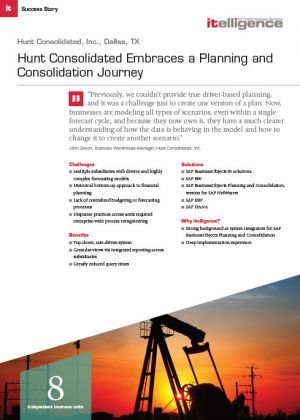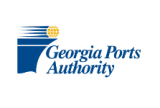
Why we've chosen intelligence:
- Strong background as system integrators for SAP BusinessObjects Planning and Consolidation
- Deep implementation experience
“Previously, we couldn’t provide true driver-based planning, and it was a challenge just to create one version of a plan. Now, businesses are modeling all types of scenarios, even within a single forecast cycle, and because they now own it, they have a much clearer understanding of how the data is behaving in the model and how to change it to create another scenario.”
John Gooch, Business Warehouse Manager
4,500 Dallas, TX
Employees Headquarters
Hunt Consolidated, Inc. is one of the largest, privately held firms with business units focused on oil and gas exploration and production, refining, LNG, power, real estate, investments, ranching and infrastructure.
Challenges and Benefits
Challenges
- Multiple subsidiaries with diverse and highly complex forecasting models
- Historical bottom-up approach to financial planning
- Lack of centralized budgeting or forecasting processes
- Disparate practices across units required enterprise-wide process reengineering
Benefits
- Top-down, rate-driven system
- Granular views via integrated reporting across subsidiaries
- Greatly reduced query times

Hunt Consolidated Embraces a Planning and Consolidation Journey
About the Project
While one subsidiary, Hunt Oil Company (HOC), operates a capital expense-based business with multiple simultaneous projects spanning years, others would rely on cash flow analysis or waterfall structure calculations. Because of these variations, budgeting and forecasting had always been the responsibility of the independent business units, with minimal centralized planning.
HOC formed a capital planning and forecasting team, supported by changing reporting requirements from its existing SAP Business Warehouse (SAP BW) system. With more insight into capital expense transactions out of SAP ERP, the team began to consider long-term forecasting in the context of defined processes to drive actuals.
With the goal of implementing the solution for each business, HOC couldn’t configure the new system for the standalone business without factoring in others’ needs. To design the landscape, the team incorporated as many similarities as possible into a harmonizing layer.
While planning models might differ considerably between units, they’d share basic entries within the general ledger view. A sub-layer would contain the models proprietary for a specific business unit, so each would have its own dimensions and calculations specific to its operational planning needs. This approach made it easier to consolidate every plan into a singular finance plan for the organization at the top.
Similar posts


Suburban is taking advantage of the improved performance of SAP ERP 6.0 and is well-positioned for future enhancements. Additionally, Suburban is realizing valuable financial savings because of the hardware refresh and transition to a virtual model.

With the SAP Business Planning and Consolidation application, CF Industries’ employees are able to run reports faster and more easily grow the existing user base. Employees are now able to enter the system and easily pull the information they seek.


In an effort to modernize its SAP system landscape, GPA is taking advantage of recent SAP innovations. With NTT DATA Business Solutions’ help, GPA set out to improve efficiency and accuracy of their inventory management and maintenance processes.